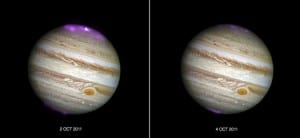
 Solar storms are triggering X-ray auroras on Jupiter that are about eight times brighter than normal over a large area of the planet and hundreds of times more energetic than Earth’s “northern lights,” according to a new study using data from NASA’s Chandra X-ray Observatory. This result is the first time that Jupiter’s auroras have been studied in X-ray light when a giant solar storm arrived at the planet.
Solar storms are triggering X-ray auroras on Jupiter that are about eight times brighter than normal over a large area of the planet and hundreds of times more energetic than Earth’s “northern lights,” according to a new study using data from NASA’s Chandra X-ray Observatory. This result is the first time that Jupiter’s auroras have been studied in X-ray light when a giant solar storm arrived at the planet.
The Sun constantly ejects streams of particles into space in the solar wind. Sometimes, giant storms, known as coronal mass ejections (CMEs), erupt and the solar winds become much stronger. These events compress Jupiter’s magnetosphere, the region of space controlled by Jupiter’s magnetic field, shifting its boundary with the solar wind inward by more than a million miles. This new study found that the interaction at the boundary triggers the X-rays in Jupiter’s auroras, which cover an area bigger than the surface of the Earth.
A series of composite images show Jupiter and its aurora during and after a CME’s arrival at Jupiter in October 2011. In these images, X-ray data from Chandra (purple) have been overlaid on an optical image from the Hubble Space Telescope. The left-hand panel reveals the X-ray activity when the CME reached Jupiter, and the right-hand side is the view two days later after the CME subsided.
The impact of the CME on Jupiter’s aurora was tracked by monitoring the X-rays emitted during two 11-hour observations. The scientists used that data to pinpoint the source of the X-ray activity and identify areas to investigate further.
The dramatic findings complement NASA’s Juno mission this summer which aims to understand the relationship between the two biggest structures in the solar system—the region of space controlled by Jupiter’s magnetic field (i.e., its magnetosphere) and the region controlled by the solar wind.
“There’s a constant power struggle between the solar wind and Jupiter’s magnetosphere,” explained William Dunn, lead author and PhD student at University College London’s Mullard Space Science Laboratory “We want to understand this interaction and what effect it has on the planet. By studying how the aurora changes, we can discover more about the region of space controlled by Jupiter’s magnetic field, and if or how this is influenced by the Sun. Understanding this relationship is important for the countless magnetic objects across the galaxy, including exoplanets, brown dwarfs and neutron stars.”
NASA’s Juno spacecraft, launched in 2011, will investigate Jupiter’s relationship with the Sun and the solar wind by studying its magnetic field, magnetosphere and aurora. The UCL team hopes to find out how the X-rays form by collecting complementary data using the European Space Agency’s X-ray space observatory, XMM-Newton, and NASA’s Chandra X-ray observatory.
“Comparing new findings from Jupiter with what is already known for Earth will help explain how space weather is driven by the solar wind interacting with Earth’s magnetosphere,” said Professor Graziella Branduardi-Raymont, supervisor of the study at UCL. “New insights into how Jupiter’s atmosphere is influenced by the Sun will help us characterize the atmospheres of exoplanets, giving us clues about whether a planet is likely to support life as we know it.”


Be the first to comment